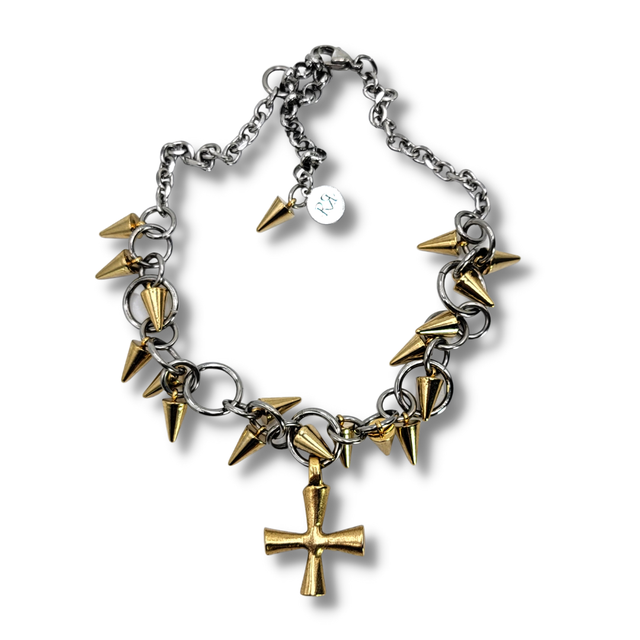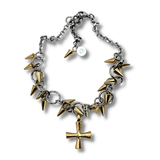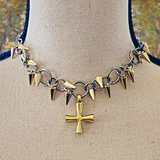- Necklaces
- >
- Maltese Cross & Spike Choker in 12k Gold Plate & Stainless Steel
Maltese Cross & Spike Choker in 12k Gold Plate & Stainless Steel
SKU:
$85.00
$65.00
$65.00
On Sale
Unavailable
per item
Length: 16" adjustable to 18"
Spikes: 14.5MM x 7MM, Stainless Steel
PENDANT:
Height: 32mm
Width: 23mm
Metal: Pewter
Finish: 12k Antiqued Gold
1 available
Meaning of the Maltese Cross: The eight points of the Maltese cross have interpretations originally connected to Christianity and the Knights Hospitaller. However, the symbol has transcended these origins to represent universal concepts today.
For many Christians, the Maltese cross represents the eight beatitudes, recounted by Jesus in the Sermon on the Mount, as outlined in the Gospel of Matthew.
The Knights of Provence, Aragon, Auvergne, Castille, Portugal, Italy, Germany, and England, considered the points of the cross to represent the eight obligations or aspirations of the knighthood.
In its most modern representation, the points symbolize the eight characteristics of a good first-aider, signifying honor, bravery, and courage in the face of adversity, with the aim of protecting and fighting for others. This makes the Maltese Cross a popular symbol for fire departments in the US, medals of honor, in places such as Sweden, Poland, Germany, and the Philippines, coats of arms, and family crests.
For many Christians, the Maltese cross represents the eight beatitudes, recounted by Jesus in the Sermon on the Mount, as outlined in the Gospel of Matthew.
- Blessed are the poor in spirit, for theirs is the kingdom of heaven.
- Blessed are those who mourn, for they shall be comforted.
- Blessed are the meek, for they shall inherit the earth.
- Blessed are those who hunger and thirst for righteousness, for they shall be satisfied
- Blessed are the merciful, for they shall receive mercy.
- Blessed are the pure in heart, for they shall see God.
- Blessed are the peacemakers, for they shall be called persons of God.
- Blessed are those who are persecuted for righteousness’ sake, for theirs is the kingdom of heaven.
The Knights of Provence, Aragon, Auvergne, Castille, Portugal, Italy, Germany, and England, considered the points of the cross to represent the eight obligations or aspirations of the knighthood.
- To live in truth
- To have faith
- To repent of one’s sins
- To be humble
- To be just
- To be merciful
- To be sincere
- To endure persecution
In its most modern representation, the points symbolize the eight characteristics of a good first-aider, signifying honor, bravery, and courage in the face of adversity, with the aim of protecting and fighting for others. This makes the Maltese Cross a popular symbol for fire departments in the US, medals of honor, in places such as Sweden, Poland, Germany, and the Philippines, coats of arms, and family crests.
- Observant – note the causes and signs of the injury
- Tactful – investigate the history of the case while winning the confidence of the patient and any others nearby
- Resourceful – use available resources to manage the situation as best as possible
- Dextrous – assist the patient without causing needless pain
- Explicit – give clear instructions to the patient and bystanders to help the patient
- Discriminating – assess the injuries and handle those that require immediate attention
- Persevering – keep persevering with the assistance, even if it appears unsuccessful
- Sympathetic – offer comfort to the patient and reduce suffering



